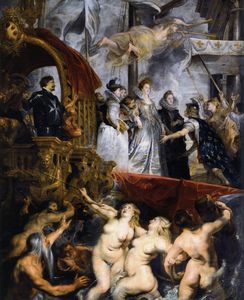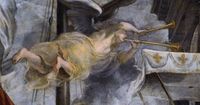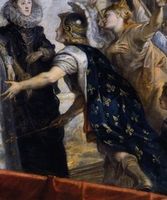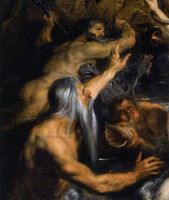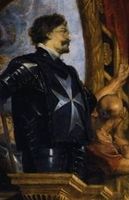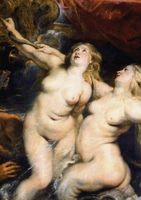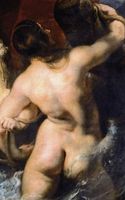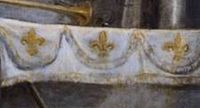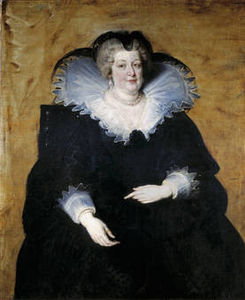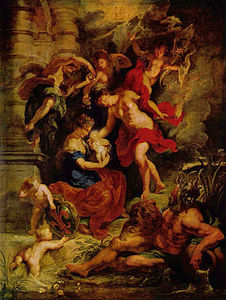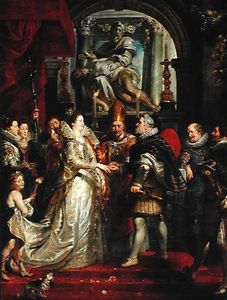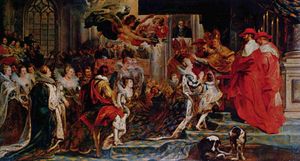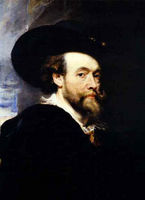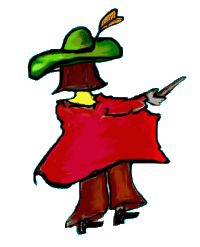The Landing of Marie de Médicis at Marseilles
- Date of Creation:
- 1625
- Alternative Names:
- The Disembarkation at Marseilles
- Height (cm):
- 394.00
- Length (cm):
- 295.00
- Medium:
- Oil
- Support:
- Canvas
- Subject:
- Scenery
- Art Movement:
- Baroque
- Created by:
- Current Location:
- Paris, France
- Displayed at:
- Musée du Louvre
- Owner:
- Musée du Louvre
- The Landing of Marie de Médicis at Marseilles Page's Content
- Story / Theme
- Inspirations for the Work
- Analysis
- Critical Reception
- Related Paintings
- Artist
- Art Period
- Bibliography
The Landing of Marie de Médicis at Marseilles Story / Theme
In 1621, Rubens was commissioned to create a series of works commemorating the life of Marie de Medici of France and her husband. These pieces were to decorate the gallery of the newly-built Palais de Luxembourg. It was agreed that the project would be completed within two years, to coincide with the marriage of Marie's daughter, Henrietta Maria.
Rubens went on to complete just twenty-one of the paintings as his work was constantly being disrupted by arguments between Marie and her son who eventually banned his mother from France in 1631.
The cycle of paintings paying tribute to the life of Henry IV were never completed but some preliminary sketches survive.
This particular painting shows Marie's arrival at Marseilles on 3 November 1600 where she would marry the French King Henry IV.
However, the marriage was not a happy one as King Henry IV was something of a lothario who cheated on Marie as he had done in his previous marriage. This infuriated Marie so much so that she invited his ex-wife back into France.
During her time as Queen, until her son could rightfully take her place, Marie grew angry and frustrated and showed little interest in the political roles she had to fulfil. In 1612 she constructed and decorated the Palais de Luxembourg in her own honor.
Rubens' version :
The Landing of Marie de Medici at Marseilles is one of Rubens' most famous pieces from this cycle. He depicts the moment a young Marie walks upon the red carpeted gang plank onto French territory, her new home and soon-to-be new kingdom. King Henry IV could not attend as he had other duties to undertake.
Rubens brings together an array of ancient and mythical Roman figures in these works as symbols to characterize the scene and Marie herself. To the top is Fame, heralding his trumpet as the young, beautiful Queen enters Marseilles. On the awning of the boat is the Medici's Coat of Arms representing Marie's heritage.
In a rich velvet blue cloak, is France represented as soldier who bears the fleur-de-lys, the national symbol. He opens his arms to welcome Marie.
Below are the three famous Nereids of Nereus. The Neireds were the 50 daughters of Nereus, the sea god. They derived from Greek mythology and were considered friendly creatures that lived in the Mediterranean Sea on which Marie travelled to get to Marseilles. They would often help ships and sailors during perilous storms and could also prophesize events.
To the left stands Neptune with a long beard reaching his arm out and calming the waves to ensure Marie's safe arrival.
Lastly, to Neptune's left, is a naked and muscular Fortune who steered the vessel amidst its perilous journey. Between Neptune and Fortune, is one of Rubens' signature horses.
The Landing of Marie de Médicis at Marseilles Inspirations for the Work
As one of Rubens's first great commissions, this series of works was rather difficult due to the fact that women at this time did not generally receive such tributes. However, Rubens was a great believer in respecting "the virtues of the opposite sex".
Further difficulties included Marie's alleged involvement in political scandal which made literal depictions of some events too risky for Rubens. To overcome this, he drew on his knowledge of classical literature and artistic traditions and used allegorical representations to elevate the mundane aspects and carefully convey the less favorable moments in Marie's life.
During the sixteenth and seventeenth centuries many artists used iconography of the Christian world and that of the Greek and Roman pantheon and this was understood by learned artists and citizens alike.
Rubens' was one such artist and his knowledge of classical mythology was used to create extravagant images of Maria, surrounded by ancient gods. The uncertainty of his figures served to portray his subject in a more positive light. Her husband Henry was more or less thrust into the background and the sequence that resulted was largely invented by Rubens.
Thus, Rubens had a great deal of artistic freedom with this work. To create it he prepared two series of detailed oil sketches, complete with figures which his assistants then had to scale up to the required dimensions of the canvasses. He then retouched them as he saw fit, so that the final products were very much his own.
It's believed that Rubens used ancient genera of writing as a narrative source for this work. He looked to genera of writing called the Panegyric which were usually written during important political events and helped to applaud the qualities and heritage of a ruler. It's thought that Rubens followed this structure when carrying out this commissioned work for Marie de Medici.
In these paintings Rubens stretched his imaginative to make the Queen Mother's rather normal existence into a masterpiece.
There was a great deal depending on this cycle, namely Rubens' international reputation. Therefore, he filled his compositions with nude goddesses and curvaceous bodies.
The Landing of Marie de Médicis at Marseilles Analysis
Composition:
The composition of The Landing of Marie de Medici at Marseilles takes on a slanted perspective like so many of Rubens' works. The drama of the scene creates a harmony as it flows into one big narrative.
The contorting bodies also add to this natural flow as they are linked and help direct the eye from right to left. Other characters, such as the representation of France and her open gesture also help the viewer to focus on the Queen.
The trumpeting Fame is also painted on a slanted dimension but from left to right, creating a sense of depth.
The color palette:
Once again Rubens uses a rich color palette in exuberance to accentuate this grand scene. He boldly uses his signature reds and a great deal of gold to emphasize the subject's royal status.
Gold is also used for the boat and the artist utilizes various tones and deep shadows to define its crevices and ornate decorations.
Reds are also shown in the traditional royal drapery as it seeps over the awning and onto the plank. Strong white sheens with gold detail are used for the central characters, such as the ladies in waiting and the Queen herself, illuminating her presence.
The fabrics become more delicate and soft with the white undercoating which helped Rubens to portray the dress's finer details as it shimmers in the light and the water reflects off it.
Light blues and grays dominate the skies and it clears way for the new Queen and the wispy clouds create shadow and depth.
Rubens uses a bold, dark green for the Medici emblem as well as mixing it with rich yellow ochres for the sprawling French landscape in the background. He also paints the bold pillars in dark grays and blacks with a tint of dark blue.
Rubens switches his conventional method of a dark top half and instead places the light to the top of the image.
He uses a multitude of lighting techniques on the fabrics to recreate it as realistically as possible and to accentuate its rich texture and color.
The Landing of Marie de Médicis at Marseilles Critical Reception
Due to the period of political upheaval during which this work was created, Rubens had to ensure that his paintings did not offend the reigning monarch. Thus, he relied on mythological allusions, symbolic references and religious analogies to create this piece.
Therefore, many can argue that Rubens' work is rather select or dishonest in terms of 'historical truth' but others claim that as Rubens was a painter and not an historian or journalist, his work can best be described as poetic transformation.
Additionally, through this work, Rubens demonstrated his organizational skills and showed that he could meet the demands of such cycles and, effectively, he revolutionized the problem of large-scale illustrative works.
This work benefitted Rubens career for years to come. It not only flaunted his capabilities as an artist but the themes and stylistic components observed in later works were derived from the Medici series.
In fact, this work went on to inspire artists such as Jean-Antoine Watteau and François Boucher who produced copies from the Medici cycle.
The Landing of Marie de Médicis at Marseilles Related Paintings
The Landing of Marie de Médicis at Marseilles Artist
Rubens spent a great deal of time studying classical, Greek and Latin texts and this had a huge influence on his career. He set himself apart from his peers with his depictions of human figures, extravagant color palette and well developed themes often based on Christian and classical traditions.
At the time he was asked to complete this cycle for Marie de Medici Rubens was perhaps the most renowned and skilled artist in Northern Europe and the monumental religious works he carried out for councils and churches were held in high regard.
Rubens welcomed the challenge from the French Monarch to create this large-scale piece and used it as an opportunity to further demonstrate his talents, this time within a secular scene.
The artist drew on his knowledge of classical mythology and he created a sequence very much from his own imagination. Thus, Rubens had a great deal of artistic freedom with this work and it went on to inspire many other artists.
This series is regarded as one of the greatest examples of Baroque art that exists today.
The Landing of Marie de Médicis at Marseilles Art Period
The Baroque style originated in Italy and its pioneers include great artists such as Michelangelo and Tintoretto. Baroque art centered on impersonal and generic works with an animated and energetic mood.
This art genre came into play at a time when the foundations of capitalism were being laid by the world's growing economies and art was expanding in new and exciting directions.
The success of the Baroque style was promoted by the Roman Catholic Church, which had decided in response to the Protestant Reformation that art should focus on religious themes and emotional involvement. The aristocracy also saw Baroque art as a means of demonstrating wealth and power.
Flemish Baroque painting developed out of the Southern Netherlands between about 1585 and 1700. Rubens played an instrumental role seventeenth-century visual culture and his works helped put Antwerp on the map as one of Europe's major artistic cities, particularly with regards to Counter-Reformation imagery.
Flemish Baroque painting saw emphasis shift to still-life, genre paintings of everyday scenes, and landscape painting. However, many artists such as Rubens preserved traditional religious subject matter.
Rubens is known for helping to develop the Baroque altarpiece.
The Landing of Marie de Médicis at Marseilles Bibliography
To find out more about Rubens and his works please refer to the recommended reading list below.
• Bertram, Anthony. The Life of Sir Peter Paul Rubens. Kessinger Publishing, 2008
• Edwards, Samuel. Peter Paul Rubens; A biography of a giant. D. McKay Co. , 1973
• Gritsay, N. Et al. Peter Paul Rubens: A Touch of Brilliance. Prestel, Oct 2003
• Kraftner, Johann. Peter Paul Rubens: 1577-1640. Thames & Hudson, 2005
• Lamster, Mark. Master of Shadows: The Secret Diplomatic Career of the Painter Peter Paul Rubens. A Talese; 1 edition, 2009
• Sutton, PC. Drawn by the Brush: Oil Sketches by Peter Paul Rubens. , Yale University Press, 2004
• Varshavskaya, Maria & Yegorova, Xenia. Peter Paul Rubens: The Pride of Life (Great Painters). Parkstone Press Ltd, 1997
• White, Christopher. Peter Paul Rubens: Man and Artist. Yale University Press, 1987

